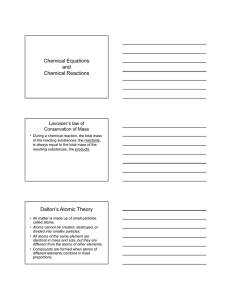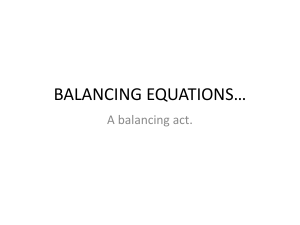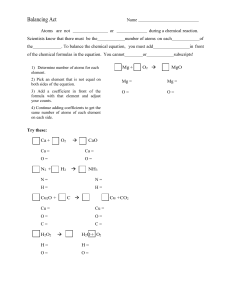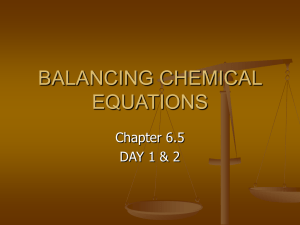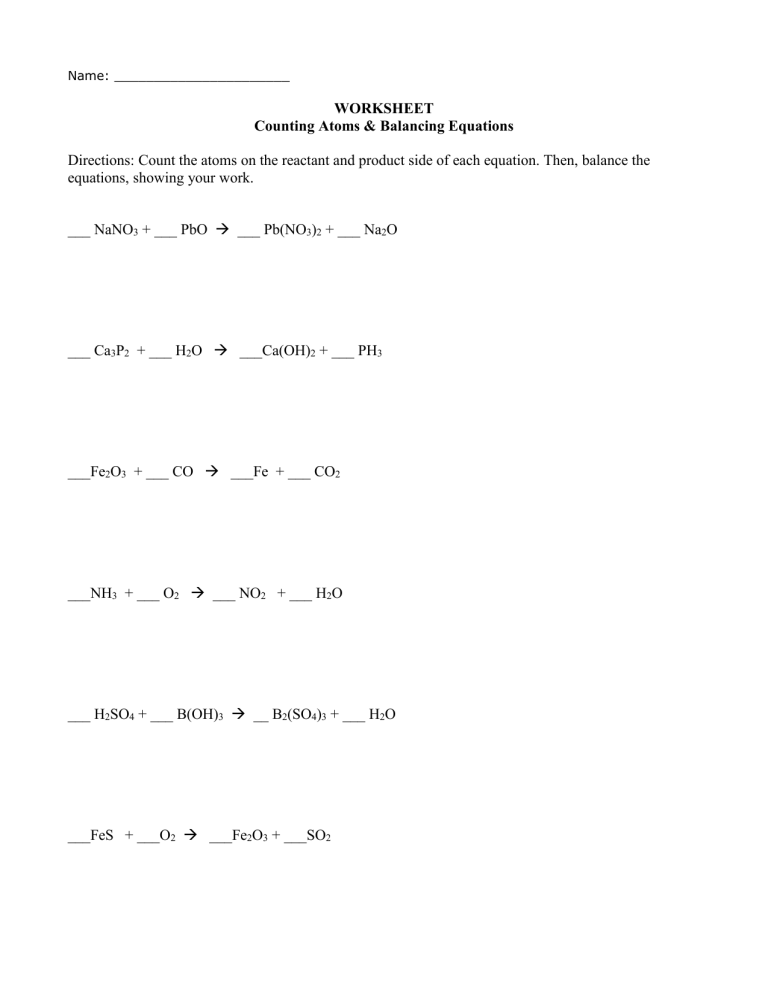
Name: ______________________ WORKSHEET Counting Atoms & Balancing Equations Directions: Count the atoms on the reactant and product side of each equation. Then, balance the equations, showing your work. ___ NaNO3 + ___ PbO ___ Pb(NO3)2 + ___ Na2O ___ Ca3P2 + ___ H2O ___Ca(OH)2 + ___ PH3 ___Fe2O3 + ___ CO ___Fe + ___ CO2 ___NH3 + ___ O2 ___ NO2 + ___ H2O ___ H2SO4 + ___ B(OH)3 __ B2(SO4)3 + ___ H2O ___FeS + ___O2 ___Fe2O3 + ___SO2 ___ C3H6O2 + ___ O2 ___ CO2 + ___ H2O ____ Fe + ____ H2O ____ Fe3O4 + ____ H2 ____Al2O3 ____Al + ____ O 2 ____ NaF + ____ CaSO4 ____ CaCl2 + ____ Na2SO4 BALANCING EQUATIONS NOTES SHEET Chemical reaction: a process where atoms of the reactant(s) will rearrange themselves to create a new arrangement of atoms, called the product(s). Reactant: A substance or substances present at the start of the reaction. Product: A resulting substance or substances formed by a chemical reaction. Chemical equation: Shorthand form for writing what reactants are used and what products are formed in a chemical reaction; sometimes shows whether energy is produced or absorbed. Chemical formula: Combination of chemical symbols and numbers that indicates which elements and how many atoms of each element are present in a molecule. Subscripts: The small numbers written to the right of the atoms. For examples, the subscript 2 in H2O means that each molecule of water has two atoms of hydrogen. A subscript outside a parenthesis multiplies all the elements inside the parenthesis. For example, Ba3(PO4)2, indicates there are 3 atoms of Ba, 2 (2 x 1) atoms of P, and 8 (2 x 4) atoms of O. Coefficients: The numbers in front of a chemical formula. For example, 2H2O means two molecules of water. Law of conservation of mass: The mass of the reactants must equal the mass of the products. All the atoms on the reactant side of and equation are also on the product side. Atoms are not lost, but rearranged. Rules for balancing chemical equations: 1. Write the correct chemical formulas of reactants and products. 2. Count the number of atoms of each type in the reactants and in the products. 3. Look at the equation and see which elements are not balanced. 4. Balance the elements one at a time by adding coefficients. 5. Count the number of atoms to make sure the equation is balanced. 6. Finally, all coefficients are converted into the lowest possible whole number. Show the students the Fig. 1, to illustrate coefficients and subscripts: Never: Change a subscript to balance a chemical equation. If you change the formula, you are describing a different chemical reaction: H2O is a different compound than H2O2. Put a coefficient in the middle of a chemical formula. 2KCl is alright, K2Cl is not


